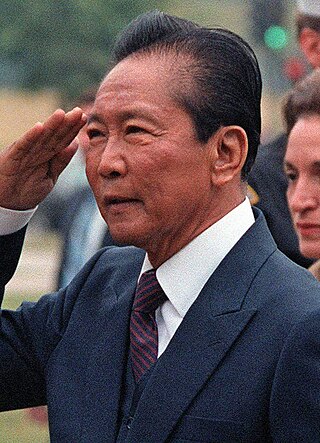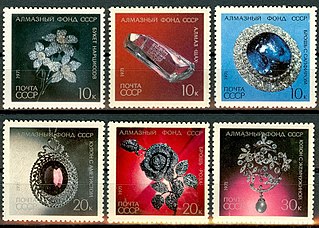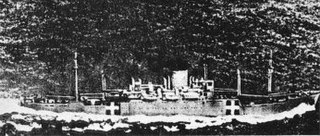
Ferdinand Emmanuel Edralin Marcos Sr. was a Filipino politician, lawyer, dictator, and kleptocrat who served as the tenth president of the Philippines from 1965 to 1986. He ruled under martial law from 1972 until 1981 and kept most of his martial law powers until he was deposed in 1986, branding his rule as "constitutional authoritarianism" under his Kilusang Bagong Lipunan. One of the most controversial leaders of the 20th century, Marcos's rule was infamous for its corruption, extravagance, and brutality.

Imelda Romuáldez Marcos is a Filipino politician who was First Lady of the Philippines from 1965 to 1986, wielding significant political power after her husband Ferdinand Marcos placed the country under martial law in September 1972. She is the mother of current president Bongbong Marcos.

Tomoyuki Yamashita was a Japanese convicted war criminal and general in the Imperial Japanese Army during World War II. Yamashita led Japanese forces during the invasion of Malaya and Battle of Singapore, his conquest of Malaya and Singapore in 70 days earned him the sobriquet "The Tiger of Malaya" and led to the British Prime Minister Winston Churchill calling the ignominious fall of Singapore to Japan the "worst disaster" and "largest capitulation" in British military history. He was assigned to defend the Philippines from the advancing Allies later in the war. Although he was unable to prevent the superior Allied forces from advancing, despite dwindling supplies and Allied guerrilla action, he was able to hold on to part of Luzon until after the formal Surrender of Japan in August 1945.

Robert Bernard Anderson was an American administrator, politician, and businessman. He served as the Secretary of the Navy between February 1953 and March 1954. He also served as the Secretary of the Treasury from 1957 until 1961, and was one of President Dwight Eisenhower's closest confidants.

Yasuhito, Prince Chichibu was the second son of Emperor Taishō (Yoshihito) and Empress Teimei (Sadako), a younger brother of Emperor Shōwa (Hirohito) and a general in the Imperial Japanese Army. As a member of the Imperial House of Japan, he was the patron of several sporting, medical, and international exchange organizations. Before and after World War II, the English-speaking prince and his wife attempted to foster good relations between Japan and the United Kingdom and enjoyed a good rapport with the British royal family. As with other Japanese imperial princes of his generation, he was an active-duty career officer in the Imperial Japanese Army. Like all members of the imperial family, he was exonerated from criminal prosecutions before the International Military Tribunal for the Far East by Douglas MacArthur.
Sterling Seagrave was an American historian. He was the author of numerous books which address unofficial and clandestine aspects of the 20th-century political history of countries in the Far East.

Prince Tsuneyoshi Takeda was the second and last heir of the Takeda-no-miya collateral branch of the Japanese Imperial Family.

The Diamond Fund is a unique collection of gems, jewelry and natural nuggets, which are stored and exhibited in the Kremlin Armoury in Russia. The Fund was opened in 1967 and its collection dates back to the Russian Crown treasury instituted by Emperor Peter I of Russia in 1719.
Rogelio "Roger" Domingo Roxas was a former Filipino soldier who had worked as a locksmith before allegedly discovering in a cave north of Manila a hidden chamber full of gold bars and a giant golden Buddha statue – which Roxas estimated to weigh one metric ton – on a plot of state-owned land near Baguio General Hospital, in Baguio on January 24, 1971. Roxas claimed that the Buddha's head was removable and that it concealed a hollowed-out portion within the statue that contained at least two handfuls of uncut diamonds. The cache was alleged to be a portion of the legendary Yamashita treasure.

The Awa Maru (阿波丸) was a Japanese ocean liner owned by Nippon Yusen Kaisha. The ship was built in 1941–1943 by Mitsubishi Shipbuilding & Engineering Co. at Nagasaki, Japan. The vessel was designed for passenger service, but the onset of war by the time work was completed changed requirements, and she was requisitioned by the Japanese Navy. While sailing as a relief ship under Red Cross auspices in 1945, she was torpedoed by USS Queenfish (SS-393), resulting in the death of all but one of the 2,004 people aboard.

Ray Steiner Cline was an official at the United States Central Intelligence Agency and is best known for being the chief CIA analyst during the Cuban Missile Crisis.

Yamashita: The Tiger's Treasure is a 2001 Filipino epic action-drama war film directed by Chito S. Roño and starring Armando Goyena, Danilo Barrios, Albert Martinez, Vic Diaz, BB Gandanghari, and Camille Prats. Its plot concerns a hidden Yamashita treasure. It was released by Star Cinema and Regal Entertainment. The film won a total of 11 awards in various award-giving bodies including the coveted Metro Manila Film Festival for Best Picture.

During the Japanese occupation of the islands in World War II, there was an extensive Philippine resistance movement, which opposed the Japanese and their collaborators with active underground and guerrilla activity that increased over the years. Fighting the guerrillas – apart from the Japanese regular forces – were a Japanese-formed Bureau of Constabulary, the Kenpeitai, and the Makapili. Postwar studies estimate that around 260,000 people were organized under guerrilla groups and that members of anti-Japanese underground organizations were more numerous. Such was their effectiveness that by the end of World War II, Japan controlled only twelve of the forty-eight provinces.
Paul Lional Edward Helliwell was an American lawyer, banker, OSS official, and CIA officer. While serving in this capacity he became director of Sea Supply, Inc. and president of Castle Bank & Trust. Helliwell was instrumental in setting up Civil Air Transport and Castle Bank & Trust, both of which were CIA proprietary companies. According to The Wall Street Journal, he was "deeply involved" in financing covert actions against Cuba from 1964 to 1975. Helliwell was reported to have played a key role in the purchase of the site for Disney World.
The Marcos Japanese ODA Scandal, referred to in Japan simply as the Marukosu giwaku (マルコス疑惑), or "Marcos scandal", refers to incidents of alleged corruption linked to Japanese Official Development Assistance (ODA) to the Philippines during Philippine president Ferdinand Marcos' administration.

The Marcos family is a political family in the Philippines. They have established themselves in the country's politics, having established a political dynasty that traces its beginnings to the 1925 election of Mariano Marcos to the Philippine House of Representatives as congressman for the second district of Ilocos Norte; reached its peak during the 21-year rule of Ferdinand Marcos as president of the Philippines that included his 14-year dictatorship beginning with the declaration of Martial Law throughout the country; and continues today with the political careers of Imelda Marcos, Imee Marcos, Sandro Marcos and reached a fresh political apex with the presidency of Bongbong Marcos.
Ferdinand Marcos developed a cult of personality as a way of remaining President of the Philippines for 20 years, in a way that political scientists have compared to other authoritarian and totalitarian leaders such as Joseph Stalin and Adolf Hitler, but also to more contemporary dictators such as Suharto in Indonesia, Saddam Hussein in Iraq, and the Kim dynasty of North Korea.

The overseas landholdings of the Marcos family, which the Philippine government and the United Nations System's Stolen Asset Recovery Initiative consider part of the $5 billion to $13 billion "ill-gotten wealth" of Ferdinand and Imelda Marcos, are said to be distributed worldwide in places including California, Washington, New York, Rome, Vienna, Australia, Antilles, the Netherlands, Hong Kong, Switzerland and Singapore. These are aside from the fifty-or-so Marcos mansions acquired by the Marcos family within the Philippines itself.
Tallano gold refers to a set of interrelated conspiracy theories and internet scams which claim that before Spain colonized the Philippines, the archipelago and surrounding territories were ruled by a certain Tagean Tallano family, that the family owned a vast amount of gold, and that former president Ferdinand Marcos obtained his family's unexplained wealth by receiving some of the Tallano gold as payment for the legal services he allegedly provided to the Tallano family. Offshoots of the conspiracy theories include tales that the country's national hero José Rizal survived his execution, that the gold reserves were used to fund the Vatican, or that the gold was instrumental in starting the World Bank.

The Yamato Dynasty: The Secret History of Japan's Imperial Family is a 1999 non-fiction book by historian Sterling Seagrave and Peggy Seagrave. The full text is divided into 13 chapters in total. The book is a biography of the Imperial Family of Japan since the Meiji Restoration stretching across five generations: Emperor Kōmei, Emperor Meiji, Emperor Taishō, Emperor Shōwa, and Emperor Heisei.















